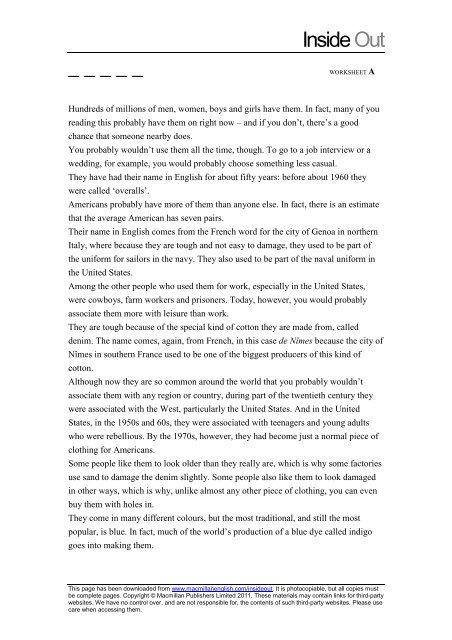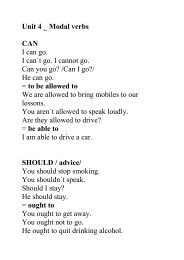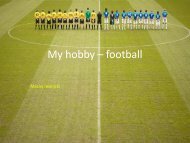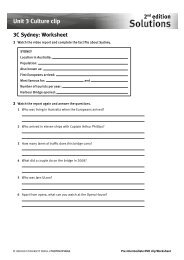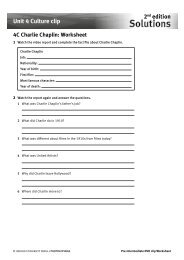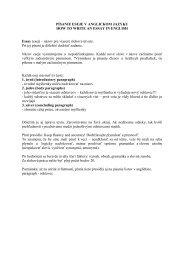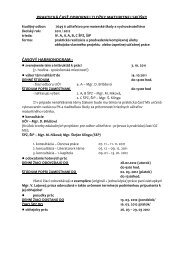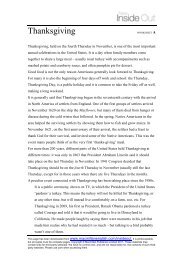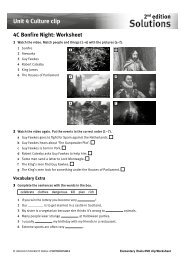Jay-Z WORKSHEET A - Inside Out
Jay-Z WORKSHEET A - Inside Out
Jay-Z WORKSHEET A - Inside Out
Create successful ePaper yourself
Turn your PDF publications into a flip-book with our unique Google optimized e-Paper software.
_ _ _ _ _<strong>Inside</strong> <strong>Out</strong><strong>WORKSHEET</strong> AHundreds of millions of men, women, boys and girls have them. In fact, many of youreading this probably have them on right now – and if you don’t, there’s a goodchance that someone nearby does.You probably wouldn’t use them all the time, though. To go to a job interview or awedding, for example, you would probably choose something less casual.They have had their name in English for about fifty years: before about 1960 theywere called ‘overalls’.Americans probably have more of them than anyone else. In fact, there is an estimatethat the average American has seven pairs.Their name in English comes from the French word for the city of Genoa in northernItaly, where because they are tough and not easy to damage, they used to be part ofthe uniform for sailors in the navy. They also used to be part of the naval uniform inthe United States.Among the other people who used them for work, especially in the United States,were cowboys, farm workers and prisoners. Today, however, you would probablyassociate them more with leisure than work.They are tough because of the special kind of cotton they are made from, calleddenim. The name comes, again, from French, in this case de Nîmes because the city ofNîmes in southern France used to be one of the biggest producers of this kind ofcotton.Although now they are so common around the world that you probably wouldn’tassociate them with any region or country, during part of the twentieth century theywere associated with the West, particularly the United States. And in the UnitedStates, in the 1950s and 60s, they were associated with teenagers and young adultswho were rebellious. By the 1970s, however, they had become just a normal piece ofclothing for Americans.Some people like them to look older than they really are, which is why some factoriesuse sand to damage the denim slightly. Some people also like them to look damagedin other ways, which is why, unlike almost any other piece of clothing, you can evenbuy them with holes in.They come in many different colours, but the most traditional, and still the mostpopular, is blue. In fact, much of the world’s production of a blue dye called indigogoes into making them.This page has been downloaded from www.macmillanenglish.com/insideout. It is photocopiable, but all copies mustbe complete pages. Copyright © Macmillan Publishers Limited 2011. These materials may contain links for third-partywebsites. We have no control over, and are not responsible for, the contents of such third-party websites. Please usecare when accessing them.
Jeans<strong>Inside</strong> <strong>Out</strong><strong>WORKSHEET</strong> BExercise 1Team AHere are the answers to some questions about the text on Worksheet A, but what arethe questions? When you have prepared the questions, Team B will have to answerthem as part of a quiz.1. It comes from (the French word for) the city of Genoa.2. Seven.3. They were called ‘overalls’.4. It is a blue dye.5. It is a tough kind of cotton.6. It is in southern France.7. In the 1950s and 60s.8. Because some people like their jeans to look older than they really are.Team BHere are the answers to some questions about the text on Worksheet A, but what arethe questions? When you have prepared the questions, Team A will have to answerthem as part of a quiz.1. Sailors in the navy.2. Denim.3. They used them for work.4. They use sand.5. It is in northern Italy.6. The West, particularly the US.7. It comes from (the French word for) the city of Nîmes.8. To a job interview or a wedding.This page has been downloaded from www.macmillanenglish.com/insideout. It is photocopiable, but all copies mustbe complete pages. Copyright © Macmillan Publishers Limited 2011. These materials may contain links for third-partywebsites. We have no control over, and are not responsible for, the contents of such third-party websites. Please usecare when accessing them.
Jeans<strong>Inside</strong> <strong>Out</strong><strong>WORKSHEET</strong> CExercise 2Student A: You and your partner have the same grid, but with different words completed. Take it inturns to describe the words to each other and fill in the gaps. When you have finished, the names inEnglish of two popular styles of jeans will read from top to bottom.1 C A S U A L23 L E I S U R E45 P A I R67 H O L E89 S A I L O R1011 R E B E L L I O U S1213 N A V Y14…………………………………………………………………………………………..Student B: You and your partner have the same grid, but with different words completed. Take it inturns to describe the words to each other and fill in the gaps. When you have finished, the names inEnglish of two popular styles of jeans will read from top to bottom.312 T R A D I T I O N A L4 A V E R A G E56 T O U G H78 C O T T O N11910 W O R K E R12 S A N D1314 D Y EThis page has been downloaded from www.macmillanenglish.com/insideout. It is photocopiable, but all copies mustbe complete pages. Copyright © Macmillan Publishers Limited 2011. These materials may contain links for third-partywebsites. We have no control over, and are not responsible for, the contents of such third-party websites. Please usecare when accessing them.


